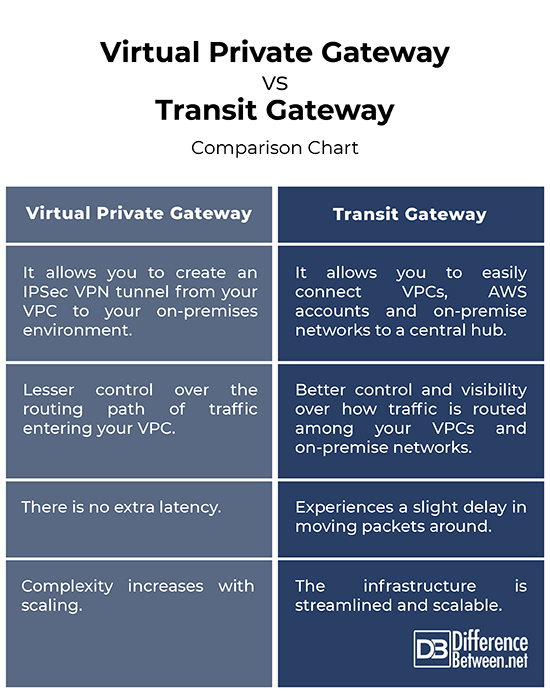Difference Between Virtual Private Gateway and Transit Gateway
AWS makes it fairly easy to connect your on-premises network with the cloud environment. One of the best ways to do this is to leverage an already available connectivity – the Internet. You can simply create a VPN connection with the AWS environment, allowing for the delivery of a reliable solution which can be used in most cases where VPN-type connectivity to AWS is required.
A VPN connection to AWS can only be used to access resources inside a VPC. Because every VPC is its own isolated network, a VPN connection per VPC is required. How do you create a site-to-site VPN between AWS and on on-premise data center? One way to terminate a VPN connection to a VPC is to use a Virtual Private Gateway.

What is Virtual Private Gateway?
A Virtual Private Gateway (VGW) is nothing but a VPN connector on the AWS side of the Site-to-Site VPN connection. It is a managed gateway endpoint for your VPC responsible for hybrid IT connectivity using VPN and AWS Direct Connect. The VGW is a logical network device that allows you to create an IPSec VPN tunnel from your VPC to your on-premises environment. The VPN tunnel is established after traffic is generated from the customer side of your VPN connection. The VGW is a self-sustained entity which is not dependent on any pre-existing VPC. Once created, it can be attached to any VPC in the same account and region. The VGW allows multiple VPCs, in the same region and on the same account, to share a Direct Connect.

What is Transit Gateway?
AWS transit gateway is a network transit hub that connects multiple VPCs and on-premise networks via virtual private networks or Direct Connect links. It is a fully-managed service by AWS that simplifies your network by stopping complex peering relationships. It easily connects VPCs, AWS accounts and on-premise networks to a central hub. In addition to simplifying connectivity, AWS Transit Gateway gives you granular control and visibility over how traffic is routed among your VPCs and on-premise networks. The best part; it maintains its own route table. This allows multiple services across multiple VPCs to communicate with each other using only one Transit Gateway and a well-configured route table.
Difference between Virtual Private Gateway and Transit Gateway
Architecture
– A Virtual Private Gateway is a logical network device that allows you to create an IPSec VPN tunnel from your VPC to your on-premises environment. Although, functional and scalable, the traditional architecture involves a lot of components which often present a series of challenges. AWS Transit Gateway offers a simpler design and allows you to easily connect VPCs, AWS accounts and on-premise networks to a central hub.
Control
– AWS Transit Gateway is a fully managed service provided by AWS that can attach itself to multiple VPCs and it maintains its own route table. You have one transit gateway route table associated with all your attachments. It gives you granular control and visibility over how traffic is routed among your VPCs and on-premise networks. You can handle monitoring and maintenance of VPCs from a central console.
Security
– Transit Gateway provides a great way of connecting distinct VPCs into a simpler hub and spoke pattern. The traffic generated between VPCs and AWS Transit Gateway is hosted on the AWS global private network, with no exposure to the public internet. The data is automatically encrypted and never roams over the public internet, and it complies with Amazon Virtual Private Cloud. This helps safeguard the network from any security exploits or DDoS attacks.
Virtual Private Gateway vs. Transit Gateway: Comparison Chart

Summary
There are pros and cons to weigh when you wish to migrate from a virtual private gateway to a transit gateway. A Transit Gateway functions as a centralized router which allows you to easily connect VPCs, AWS accounts and on-premise networks to a central hub, allowing you to easily monitor and maintain traffic through a central console. Simply put, it provides a great way of connecting distinct VPCs into a simpler hub and spoke pattern. The Virtual Private Gateway is a great way to connect VPCs to on-premises environment.
What is a virtual private gateway?
A Virtual Private Gateway is a managed gateway endpoint for your VPC that enables you to establish an IPSec VPN tunnel from your VPC to your on-premises environment.
How do I migrate my VPN from a virtual private gateway to a transit gateway?
First, you have to log in into the AWS Management Console and then go to the VPC Console. In the navigation panel on the left, go to Transit Gateway and click on ‘Create Transit Gateway’, and fill in the name and description. Now, create VPC attachments for the spoke VPCs and create Transit Gateway VPN connections to on-premises networks. Then, navigate to the Transit Gateway Route Table pane and click on Create Routes. Configure the Transit Gateway route tables and you’re all set.
Is AWS transit gateway a VPN?
AWS Transit Gateway connects multiple VPCs and on-premise networks via virtual private networks or Direct Connect links through a single gateway device.
How do I use transit gateway?
Go to the Amazon VPC Console and on the navigation pane, choose Transit Gateway, and then click on ‘Create Transit Gateway.’
What is a transit gateway attachment?
A Transit Gateway attachment is both a source and destination of packets. It controls how traffic flows among the attached network resources, which include VPCs, VPNs, Direct Connection Gateways, or other Transit Gateways.
- Difference Between Caucus and Primary - June 18, 2024
- Difference Between PPO and POS - May 30, 2024
- Difference Between RFID and NFC - May 28, 2024
Search DifferenceBetween.net :
References :
[0]Tiller, James S. A Technical Guide to IPSec Virtual Private Networks. Florida, United States: CRC Press, 2017. Print
[1]Tiller, James S. A Technical Guide to IPSec Virtual Private Networks. Florida, United States: CRC Press, 2017. Print
[2]Sluga, Marko. AWS Certified Advanced Networking - Specialty Exam Guide: Build Your Knowledge and Technical Expertise as an AWS-certified Networking Specialist. Birmingham, United Kingdom: Packt Publishing, 2019. Print
[3]Chauhan, Sidhartha, et al. AWS Certified Advanced Networking Official Study Guide: Specialty Exam. New Jersey, United States: John Wiley & Sons, 2018. Print
[4]Piper, Ben and David Clinton. AWS Certified Solutions Architect Study Guide with Online Labs: Associate SAA-C02 Exam. New Jersey, United States: John Wiley & Sons, 2021. Print
[5]Raje, Gaurav. Security and Microservice Architecture on AWS: Architecting and Implementing a Secured, Scalable Solution. California, United States: O’Reilly Media, 2021. Print
[6]Image credit: https://d1.awsstatic.com/product-marketing/transit-gateway/tgw-after.d85d3e2cb67fd2ed1a3be645d443e9f5910409fd.png
[7]Image credit: https://commons.wikimedia.org/wiki/File:SSL_VPN_Topology-en.svg
